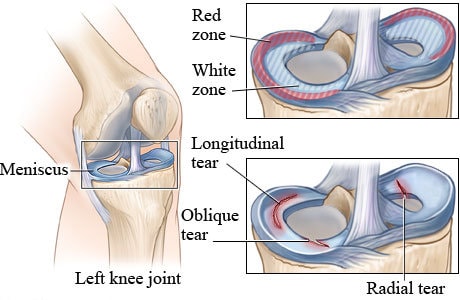Knee Meniscus Injury: Sports Chiropractor Discusses Causes, Symptoms & Management. Have A Question? Speak To Us Today. Call (24/7): 1300-003-777.
The meniscus is a fibrous cartilage structure that is situated between the femur (thigh bone) and tibia (lower leg) and acts to absorb shock that the body sustains during movement and activity. This ensures that the surface of the knee joint remains healthy and undamaged. The meniscus of the knee consists of a medial meniscus and lateral meniscus portion. It’s common for people to suffer a meniscus injury during activities such as twisting the knee while it’s slightly flexed. Sports players or recreational athletes commonly experience meniscus injuries. As you get older your meniscus becomes more susceptible to degeneration and tears due to knee joint arthritis. In situations like these surgical intervention may be warranted to repair the knee joint surface and meniscus injury.
Signs & Symptoms Of A Meniscus Tear
People who consult with a Sports Chiropractor or Physiotherapist will usually report that they experienced the onset of knee pain following activity. During discussion it may be noted that they felt a twisting injury while bending, landing or jumping. Associated symptoms of meniscus injury include:
- Knee pain during walking, running, landing or jumping.
- A sensation of clicking or popping within the knee joint during movement.
- The knee may become locked or stiff during extension and flexion.
- Generalized knee swelling may be present.
- Tenderness upon palpation of the medial and lateral knee joint surfaces.
Torn Meniscus Treatment & Rehabilitation
Depending upon the severity of your meniscus injury, treatment will generally aim to:
- Reduce pain and inflammation of the knee joint.
- Return normal knee joint movement and range of motion as promptly as possible.
- Balance muscle strength and symmetry.
- Improve patellofemoral function if required.
- Return to usual activity or sport.
Will Torn Cartilage In The Knee Repair Iteself?
Injuries require adequate blood supply to provide nutrition and healing properties. Unfortunately, meniscus have an extremely poor bloody supply meaning there healing potential is very limited. The meniscus has two distinct portions which influence their ability to heal which include:
- Red Zone
- Has poor blood supply from the synovial capsule
- White Zone
- Has no blood supply, therefore requires intervention to assist management
Chiropractor Meniscus Injury Research
- Middle-aged patients who have suffered meniscus injury may benefit from surgical intervention in addition to a structured exercise program. Gauffin, H. (2014). Knee arthroscopic surgery is beneficial to middle-aged patients with meniscal symptoms: a prospective, randomized, single blinded study. Osteoarthritis & Cartilage, 22(11); 1808 – 1816.
- The menisci of the knee are complex structures with various important functions within the knee joint. Loss of the menisci leads to a significantly increased risk of developing degenerative changes in the long term. McDermott, I. (2008). Biomechanics of the menisci of the knee. Orthopaedics & Trauma, 22(3); 193 – 201.

Additional Information
If you wish to continue your reading about Knee Meniscus injury please click here.
